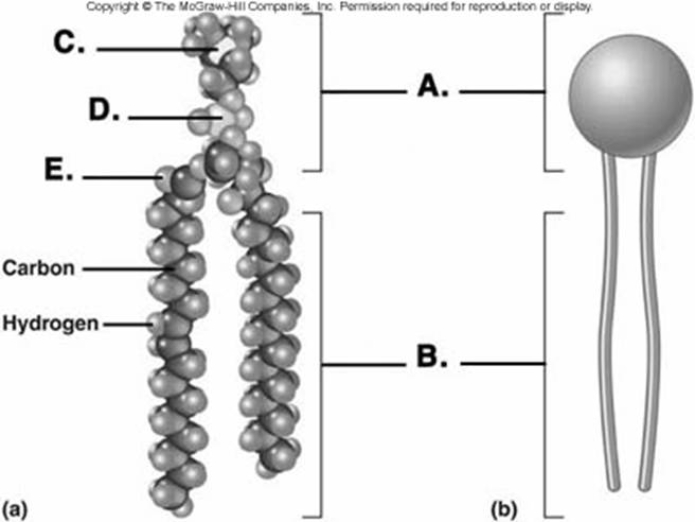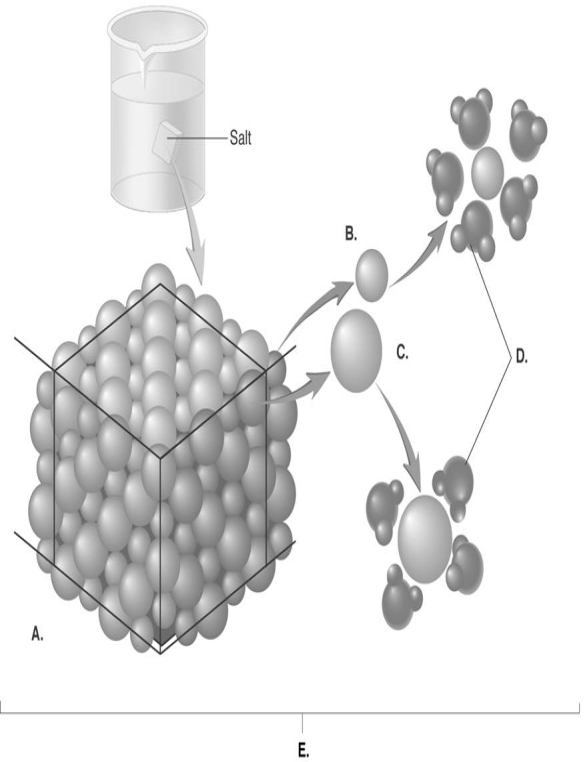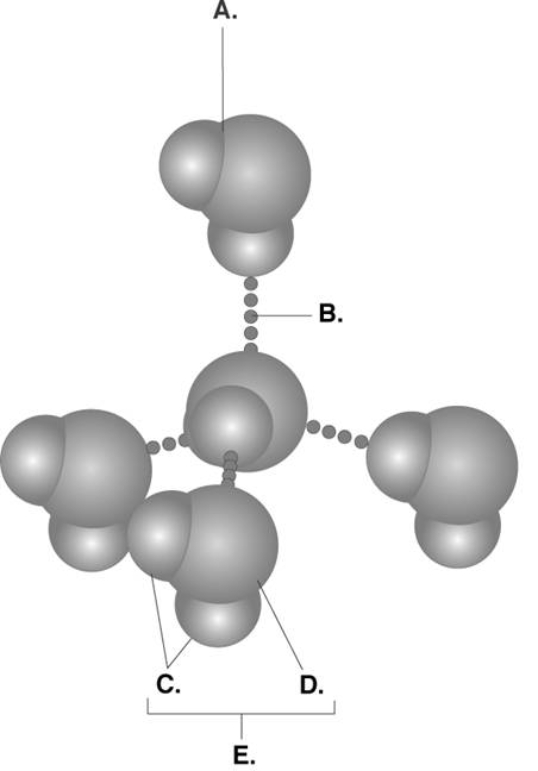A) mass.
B) weight.
C) density.
D) volume.
E) size.
G) C) and D)
Correct Answer

verified
Correct Answer
verified
Multiple Choice
Arrange the following from largest to smallest: (1) nucleus (2) DNA molecule (3) skin cell (4) chicken eggs
A) 1, 2, 3, 4
B) 4, 3, 1, 2
C) 3, 4, 2, 1
D) 2, 3, 1, 4
E) 4, 2, 3, 1
G) All of the above
Correct Answer

verified
Correct Answer
verified
Multiple Choice
Eicosanoids
A) are structural proteins.
B) are fat-soluble vitamins.
C) are components of the plasma membrane.
D) comprise the genetic material.
E) play a role in the response of tissues to injuries.
G) A) and D)
Correct Answer

verified
Correct Answer
verified
Multiple Choice
 -Phospholipids are important components of the plasma membrane. What does "C" represent on the diagram?
-Phospholipids are important components of the plasma membrane. What does "C" represent on the diagram?
A) phosphorus
B) oxygen
C) nitrogen
D) polar (hydrophilic) region
E) nonpolar (hydrophobic) region
G) All of the above
Correct Answer

verified
Correct Answer
verified
Short Answer
The element uranium has a mass number of 238 and contains 92 protons. What is the atomic number of uranium?
Correct Answer

verified
Correct Answer
verified
Multiple Choice
A group of water molecules are held together by
A) salt.
B) hydrogen bonds.
C) ionic bonds.
D) double covalent bonds.
E) polar covalent bonds.
G) A) and E)
Correct Answer

verified
Correct Answer
verified
Multiple Choice
Triglycerides are composed of
A) monosaccharides.
B) amino acids.
C) nucleotides.
D) glycerol and fatty acids.
E) None of these choices are correct.
G) C) and E)
Correct Answer

verified
Correct Answer
verified
Multiple Choice
An organic molecule consists of carbon, hydrogen, oxygen, nitrogen, and sulfur; the molecule is probably
A) carbon dioxide.
B) an amino acid.
C) a triglyceride (fat) .
D) a monosaccharide.
E) a phospholipid.
G) A) and E)
Correct Answer

verified
Correct Answer
verified
Multiple Choice
Isotopes of the same element have
A) the same number of neutrons but different numbers of protons.
B) different numbers of protons and electrons.
C) the same mass number.
D) the same atomic number but differ in their mass numbers.
E) no mass number.
G) B) and D)
Correct Answer

verified
Correct Answer
verified
Multiple Choice
Electrolytes are substances that
A) form covalent bonds with water.
B) conduct electricity when dissolved in water.
C) cannot conduct electricity in solution.
D) are NOT found in the human body in any appreciable amounts.
E) are NOT charged particles.
G) A) and E)
Correct Answer

verified
Correct Answer
verified
Multiple Choice
Adjacent amino acids in a polypeptide chain are held together by
A) hydrogen bonds.
B) ionic bonds.
C) Van der Waals bonds.
D) peptide bonds.
E) high energy bonds.
G) B) and C)
Correct Answer

verified
Correct Answer
verified
Multiple Choice
Which of the following molecules is NOT made from cholesterol?
A) estrogen
B) bile salts
C) testosterone
D) prostaglandins
E) progesterone
G) B) and D)
Correct Answer

verified
Correct Answer
verified
Multiple Choice
 -The sodium chloride molecule breaks apart in water. What does "E" represent (the process) ?
-The sodium chloride molecule breaks apart in water. What does "E" represent (the process) ?
A) chloride ion
B) dissociation
C) water molecule
D) sodium ion
E) salt crystal
G) B) and D)
Correct Answer

verified
Correct Answer
verified
Short Answer
The newly discovered element "zinferon" has a mass number of 425 and contains 125 protons. How many neutrons does an atom of this element contain?
Correct Answer

verified
Correct Answer
verified
Multiple Choice
Which of the following organic groups does hemoglobin belong to?
A) carbohydrate
B) protein
C) lipid
D) nucleic acid
E) vitamin
G) B) and D)
Correct Answer

verified
Correct Answer
verified
Multiple Choice
Which of the following organic groups does an enzyme belong to?
A) carbohydrate
B) protein
C) lipid
D) nucleic acid
E) vitamin
G) A) and E)
Correct Answer

verified
Correct Answer
verified
Multiple Choice
Enzymes are proteins that increase the rate of chemical reactions by
A) increasing the activation energy of the reaction.
B) decreasing the activation energy of the reaction.
C) adjusting the temperature of the reaction.
D) increasing the concentration of the reactants.
F) All of the above
Correct Answer

verified
Correct Answer
verified
Multiple Choice
Hyperventilation causes the loss of large amounts of carbon dioxide from the body, decreasing the amount of hydrogen ions in solution. As a result,
A) the pH of body fluids will rise.
B) the pH of body fluids will fall.
C) the pH of body fluids will become neutral.
D) the pH of body fluids will not be affected.
E) None of these choices is correct.
G) C) and E)
Correct Answer

verified
Correct Answer
verified
Multiple Choice
If the potential energy in the chemical bonds of the reactants is greater than the potential energy in the chemical bonds of the product,
A) energy must be supplied for the reaction to occur.
B) energy is released by the reaction.
C) the chemical reaction equalizes the potential energy levels.
D) energy has not been gained or lost.
E) energy is not a factor in the reaction.
G) A) and C)
Correct Answer

verified
Correct Answer
verified
Multiple Choice
 -Water accounts for 50% of the weight of a young adult female and 60% of a young adult male. What kind of bond is found at "A"?
-Water accounts for 50% of the weight of a young adult female and 60% of a young adult male. What kind of bond is found at "A"?
A) hydrogen bond
B) water molecule
C) oxygen atom
D) hydrogen atom
E) polar covalent bond
G) B) and C)
Correct Answer

verified
Correct Answer
verified
Showing 41 - 60 of 155
Related Exams